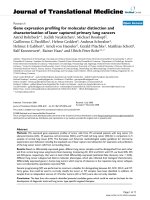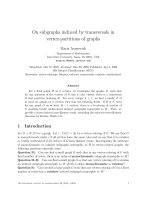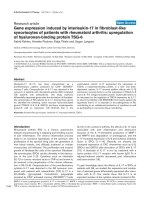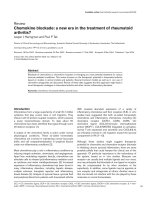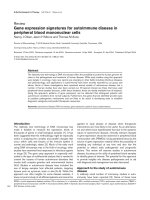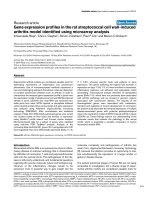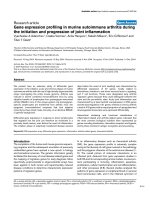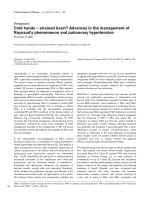Báo cáo y học: "Gene expression induced by interleukin-17 in fibroblast-like synoviocytes of patients with rheumatoid arthritis: upregulation of hyaluronan-binding protein TSG-6" doc
Bạn đang xem bản rút gọn của tài liệu. Xem và tải ngay bản đầy đủ của tài liệu tại đây (126.29 KB, 7 trang )
R186
Introduction
Rheumatoid arthritis (RA) is a chronic autoimmune
disease characterized by a relapsing and remitting course
of joint inflammation. The chronic inflammation process
leads to an excessive hyperplasia of the synovium with
proliferation of the synovial lining cells, the generation of
new blood vessels, and diffusely scattered or nodular
mononuclear cell infiltrates. The proliferation and invasive
growth of fibroblast-like cells of the synovium (fibroblast-
like synoviocytes; SFCs) results ultimately in the destruc-
tion of the joint [1,2]. Cytokines such as interleukin
(IL)-1β or tumour necrosis factor-α (TNF-α) are known to
be involved in the perpetuation of the chronic inflamma-
tion in RA [3–6]. Overproduction of the proinflammatory
cytokine IL-17 was detected in the RA synovium com-
pared with patients with osteoarthritis [7,8]. IL-17 is a
20–30 kDa glycosylated, homodimeric polypeptide
secreted by CD4
+
activated memory (CD45RO
+
) T cells
[9,10]. In the context of arthritis, the effects of IL-17 were
associated with joint inflammation and destruction
because of the IL-17-stimulated production of MMP-1
and MMP-9 and degradation of proteoglycan, and the
IL-17-increased expression of IL-6 and leukemia inhibitory
factor in SFCs [11–14]. Recently we showed the
increased expression of CXC chemokines such as IL-8,
GRO-α and GRO-β after stimulation of SFCs with IL-17
[15]. A blockade of IL-17 in vivo by treatment with a
fusion protein of IL-17 receptor with human IgG1 Fc in
adjuvant-induced arthritis decreased joint inflammation
and bone erosion [16].
To gain knowledge about the effects of IL-17 in SFCs of
patients with RA, we studied the expression and modula-
tion of selected genes differentially expressed after stimu-
lation with IL-17. Our results show that IL-17 is an
important member of the cytokine network involved in RA.
BMP-6 = bone morphogenetic protein-6; IL-17 = interleukin-17; MAPK = mitogen-activated protein kinase; RT–PCR = reverse transcriptase–
polymerase chain reaction; RA = rheumatoid arthritis; SFC = fibroblast-like synoviocytes; TBST = tris-buffered saline containing Tween 20;
TNF-α = tumour necrosis factor-α; TSG-6 = product of TNF-stimulated gene-6.
Arthritis Research & Therapy Vol 5 No 4 Kehlen et al.
Research article
Gene expression induced by interleukin-17 in fibroblast-like
synoviocytes of patients with rheumatoid arthritis: upregulation
of hyaluronan-binding protein TSG-6
Astrid Kehlen, Annette Pachnio, Katja Thiele and Jürgen Langner
Institute of Medical Immunology, Martin Luther University, Halle, Germany
Corresponding author: Astrid Kehlen (e-mail: )
Received: 30 Jul 2002 Revisions requested: 12 Sep 2002 Revisions received: 19 Mar 2003 Accepted: 21 Mar 2003 Published: 28 Apr 2003
Arthritis Res Ther 2003, 5:R186-R192 (DOI 10.1186/ar762)
© 2003 Kehlen et al., licensee BioMed Central Ltd (Print ISSN 1478-6354; Online ISSN 1478-6362). This is an Open Access article: verbatim
copying and redistribution of this article are permitted in all media for any purpose, provided this notice is preserved along with the article's original
URL.
Abstract
Interleukin-17 (IL-17) has been characterized as a
proinflammatory cytokine produced by CD4
+
CD45RO
+
memory T cells. Overproduction of IL-17 was detected in the
synovium of patients with rheumatoid arthritis (RA) compared
with patients with osteoarthritis. This study examines
differentially expressed genes after the stimulation of fibroblast-
like synoviocytes of RA patients by IL-17. Among these genes
we identified the following: tumor necrosis factor-stimulated
gene-6 (TSG-6), IL-6, IL-8, GRO-β, and bone morphogenetic
protein-6 with an expression 3.6–10.6-fold that in the
unstimulated control. IL-17 augmented the expression of
TSG-6, a hyaluronan-binding protein, in a time- and dose-
dependent manner. IL-17 showed additive effects with IL-1β
and tumour necrosis factor-α on the expression of TSG-6, IL-6
and IL-8. The mitogen-activated protein kinase p38 seems to
be necessary for the regulation of TSG-6 expression by IL-17,
as shown by inhibition with SB203580. Our results support the
hypothesis that IL-17 is important in the pathogenesis of RA,
contributing to an unbalanced production of cytokines as well
as participating in connective tissue remodeling.
Keywords: fibroblast-like synoviocytes, interleukin-17, rheumatoid arthritis, TSG-6
Open Access
Available online />R187
Materials and methods
Cell culture
SFCs were obtained from nine patients with classical or
definite RA (range of ages 27–71 years, with a mean age
(± SEM) of 51.9 ± 16.4 years) undergoing surgical syn-
ovectomy, by dissociating the minced tissue enzymati-
cally with HBSS (Hank’s buffered saline solution)
containing 0.5 mg/ml collagenase type II (Sigma, Deisen-
hofen, Germany), 0.15 mg/ml DNase I (Boehringer
Mannheim, Germany) and 5 mM Ca
2+
. The cells were cul-
tured in RPMI 1640 medium containing 10% fetal calf
serum, antibiotics and glutamine, as described previously
[17]. Cells were used at confluence at the third to fifth
passage. The inhibitors calphostin C (20 µg/ml; Sigma,
Deisenhofen, Germany), PD98059 (10 µM; Alexis, Grün-
berg, Germany), SB203580 (1 µM; Calbiochem, Schwal-
bach, Germany) and genistein (10 µg/ml; Gibco BRL,
Karlsruhe, Germany) were added to the cultures 30 min
before incubation with IL-17. Rabbit neutralizing poly-
clonal anti-hIL-17 antibody (2 µg/ml; Cell Concepts) was
co-incubated for 30 min with recombinant IL-17 and
added to the cultures.
cDNA synthesis and cDNA array
Isolation of total cellular RNA was described previously
[18]. RNA was treated with DNase I (Qiagen) and resus-
pended in water. The first strand of DNA was synthesized
(after a 10 min incubation at 20°C) at 42°C for 50 min by
using 500 ng of total RNA in 5.5 µl of diethyl pyrocarbon-
ate water (0.1% diethyl pyrocarbonate-treated water), 2 µl
of 5 × first-strand buffer (250 mM Tris/HCl pH 8.3,
375 mM KCl, 15 mM MgCl
2
), 0.5 µl of dNTP mix (10 mM
of each of dATP, dCTP, dGTP, and dTTP), 1 µl of 0.1 M
dithiothreitol, 0.5 µl (50 pmol) of random primer (Roche,
Mannheim, Germany), and 0.5 µl of Superscript™ II-RT
(200 U/µl; Invitrogen, Karlsruhe, Germany). For quantita-
tive RT–PCR, standard RNA and total RNA were con-
verted into cDNA in separate tubes in triplicate.
Total RNA (4-µg, pooled from cultured SFCs of a female
RA patient 41 years old) served as starting material for
the preparation of a [α-
32
P]dCTP-labeled cDNA with the
cDNA Synthesis Primer Mix (Clontech). For investigating
differential gene expression, cDNA was hybridized to the
Atlas™ Human 1.2 Array (Clontech) in accordance with
the user manual. This array includes 1176 human
cDNAs, housekeeping genes and negative controls
immobilized on a nylon membrane. After hybridization
and washing, the array membrane was exposed to a
phosphorimaging screen. Data analysis was performed
with AtlasImage Software 1.0. Expression values of tran-
scripts were normalized to the total signal intensity on
the membrane. In agreement with the indications of the
manufacturers, transcripts with a ratio of normalized
expression levels of more than 2 or less than 0.5 were
regarded as modulated.
Construction of RNA standards
The standards were constructed by previously described
procedures [15]. In brief, for the construction of standard
RNA, a composite primer was synthesized (see Table 1 for
primer sequences). Primer 1 contained a sequence for the
SP6 RNA polymerase and also one of the specific
sequences of the appropriate gene. The product of the
PCR amplification with primers 1 and 2 was gel-purified
(QIA quick Gel Extraction Kit; Qiagen, Hilden, Germany)
followed by transcription in vitro by the SP6 promoter with
the Roche transcription system. The recombinant RNA
was quantified by the measurement of A
260
and used as a
standard (after cDNA synthesis) in the quantitative
RT–PCR reaction.
Quantitative PCR analysis
For quantification, 1 µl of the reverse transcriptase reac-
tion mixture was added to 25 µl of reaction mixture con-
sisting of 1 × reaction buffer, 1.5 U of Taq polymerase
(Qiagen), 1.8 mM MgCl
2
, 0.1 × SYBR Green (Biozym,
Hess. Oldendorf, Germany), dNTPs (each at 200 µM), and
primers 3 and 2 (each at 0.5 µM) (Table 1). A negative
control without template was included. Samples of six
dilutions of the standard cDNA and of the target cDNA
were run in triplicate in a Rotor-Gene 2000 (LTF, Wasser-
burg, Germany). Initial denaturation at 95°C for 300 s was
followed by 40 cycles denaturation at 95°C for 15 s,
annealing at 60°C for 30 s, and elongation at 72°C for
20 s. The fluorescence intensity of the double-strand-spe-
cific SYBR Green, reflecting the amount of PCR product
formed, was read after each elongation step at 82°C. RNA
amounts were determined with the software Rotor-Gene
version 4.04 in quantitation mode.
Western blotting
Supernatants of IL-17-treated SFCs (20 ng/ml) were col-
lected and, after being washed twice with ice-cold PBS,
cells were harvested by scraping into ice-cold RIPA buffer
(1 × PBS, 1% Nonidet P40, 0.5% sodium deoxycholate).
Inhibitors were added in the following concentrations:
1 mM PMSF, 1 µg/ml aprotinin, 1 µg/ml leupeptin, 1 µg/ml
pepstatin, 1 mM Na
3
VO
4
, and 1 mM NaF (Sigma). The cell
lysate was transferred to microcentrifuge tubes and incu-
bated on ice for 60 min; centrifugation was for 20 min at
14,000 r.p.m. and 4°C. Protein concentration in the super-
natant was quantified with the BCA (bicinchoninic acid)
Protein Assay Reagent Kit (KMF, Leipzig, Germany), and
40 µg of cell lysate protein or cell culture supernatant was
used for Western blot analysis. Proteins were electroblot-
ted from NuPAGE gels (NOVEX, Frankfurt-Hoechst,
Germany) onto Hybond ECL (enhanced chemilumines-
cence) membrane (Amersham, Freiburg, Germany). The
membrane was blocked for 1 hour with 5% milk in Tris-
buffered saline containing Tween 20 (TBST; pH 7.5, 0.1%
Tween 20) at 23 ± 2°C. Blots were incubated with the
primary antibody (against TNF-stimulated gene-6
Arthritis Research & Therapy Vol 5 No 4 Kehlen et al.
R188
[anti-TSG-6], 1:1000 dilution; kindly provided by Dr MT
Bayliss, Oxford, UK) in TBST with 5% milk at 23 ± 2°C for
2 hours. Blots were washed three times and then incu-
bated for 1 hour with the secondary antibody (1:1000
dilution; Dianova, Hamburg, Germany) coupled with
horseradish peroxidase. Immunodetection was accom-
plished with ECL Western blotting detection reagents
(Amersham) for chemiluminescent detection. Immunoreac-
tivity was quantified by scanning densitometry with the
software Scan Pack version 3.0 (Biometra).
Measurement of IL-6 and IL-8
SFCs were cultured for 72 hours in the presence of
20 ng/ml IL-17. Supernatants were collected and assayed
for IL-6 and IL-8 with the Chemiluminescence-Enzyme
Immunoassay System, Immulite (DPC Biermann, Bad
Nauheim, Germany).
Statistical analysis
Data are expressed as means ± SEM. The Wilcoxon rank
sum test was used to determine whether two experimental
values were significantly different.
Results
Transcriptional activation by IL-17
Cultured SFCs were stimulated for 24 hours with
20 ng/ml IL-17 and differentially expressed genes were
analyzed with cDNA array technology. As expected, a set
of stimulated transcripts was represented by cytokines
and growth factors, including IL-6, IL-8, GRO-β, and bone
morphogenetic protein-6 (BMP-6). For the first time we
identified the gene of hyaluronan-binding protein TSG-6
as an IL-17-target gene. The expression of the oncogene
c-myc was downregulated. The differential expression of
the genes was verified by real-time RT–PCR. As shown in
Figure 1, we confirmed the upregulation of transcripts of
IL-6 (4.2-fold), IL-8 (7.06-fold), GRO-β (10.6-fold), and
BMP-6 (3.67-fold) in SFCs obtained from six different RA
patients. The mRNA expression of TSG-6 was 4.08-fold
higher after stimulation with IL-17 in SFCs of nine different
patients with RA. Furthermore, we confirmed the inhibition
of c-myc expression.
IL-17 shows additive effects with IL-1
ββ
and TNF-
αα
on the
expression of IL-6 and IL-8
To confirm the array data and the results of real-time
RT–PCR on the protein level, we measured the secretion
of IL-6 and IL-8 in SFCs after stimulation with IL-17
(20 ng/ml). After 72 hours, the secreted IL-6 and IL-8
amounts were 40.4-fold and 27.7-fold, respectively, those
of the untreated control SFCs. We detected an increase
in IL-6 level after stimulation with IL-1β (10ng/ml) and
TNF-α (10 ng/ml) to 372-fold and 109-fold, respectively,
and in combination with IL-17 to 434-fold and 432-fold,
respectively. We also found an augmentation of IL-8
protein secretion after treatment with IL-1β or TNF-α to
1185-fold and 295-fold, respectively. Combinations of
IL-1β and IL-17, or TNF-α and IL-17, showed additive
effects on IL-8 secretion of 1654-fold and 1593-fold,
respectively (Fig. 2).
Upregulation of hyaluronan-binding protein TSG-6 by IL-17
To learn more about the IL-17-stimulated expression of
TSG-6, we studied the effect of different IL-17 concentra-
Table 1
Sequences of primers used for standard construction and PCR amplification
Gene Number Sequence 5′→3′
TSG-6 1 GAT TTA GGT GAC ACT ATA GAA TAC
CCA GGC TTC CCA AAT GAG TA
2 TTG ATT TGG AAA CCT CCA GC
3 CCA GGC TTC CCA AAT GAG TA
GRO-β 2 GGC CAT TTT CTT GGA TTC CT
3 CCG AAG TCA TAG CCA CAC TC
IL-6 2 GAA GAG CCC TCA GGC TGG ACT G
3 AGT AAC TCC TTC TCC ACA AGC GC
IL-8 2 TCT CAG CCC TCT TCA AAA ACT TCT C
3 ATG ACT TCC AAG CTG GCC GTG GCT
BMP-6 2 CAC CAT GAA GGG CTG CTT AT
3 GGA CAC CCG TGT AGT ATG GG
c-myc 2 GCT GCT ATG GGC AAA GTT TC
3 AGT AAT TCC AGC GAG AGG CA
BMP-6, bone morphogenetic protein-6; IL, interleukin; TSG-6, product of tumour necrosis factor-stimulated gene-6.
tions (1–100 ng/ml) and of different incubation times
(3–48 hours). After 24 hours of IL-17 incubation, signifi-
cantly higher TSG-6 mRNA levels were observed at IL-17
concentrations between 20 and 100 ng/ml (Fig. 3). We
also quantified the transcript level of TSG-6 after IL-17
stimulation with combinations of the cytokines IL-1β and
TNF-α. As shown in Figure 4, we detected an upregulation
of TSG-6 expression with IL-1β (11.1-fold) as well as with
TNF-α (12.9-fold), whereas with IL-17 (20ng/ml) alone
the increase in TSG-6 amount was 4.08-fold. Combina-
tions of IL-1β and IL-17, or TNF-α and IL-17, showed addi-
tive effects on TSG-6 expression of 13.6-fold and
16.6-fold, respectively. An IL-17 concentration of 50 ng/ml
also synergized with IL-1β and TNF-α to induce the
TSG-6 transcript levels. Co-incubation with an anti-IL-17
antibody markedly decreased the IL-17-induced expres-
sion of TSG-6 mRNA.
Having observed IL-17-mediated TSG-6 transcript stimula-
tion, it was important to assess whether protein production
was, in fact, stimulated. As shown in Figure 5, and in agree-
ment with mRNA data, exposure of SFCs to 20 ng/ml IL-17
for 48 hours was a potent inducer of TSG-6 protein
secreted in the cell culture supernatant (shown in Fig. 5) as
well as in the cell extract (data not shown). TSG-6 was
detected in both its 35 and 120 kDa forms; the latter was
identified as a complex of TSG-6 with the serum protein
inter-α-inhibitor. The concentrations of both forms were
Available online />R189
Figure 2
Combined effects of IL-17 (20 ng/ml) plus IL-1β (10 ng/ml) or IL-17 plus
TNF-α (10 ng/ml) on the expression of IL-6 and IL-8. Fibroblast-like
synoviocytes were cultured for 72 hours in the presence of cytokines,
and the concentrations of IL-6 or IL-8 in supernatants were determined.
Measurements were made on synoviocytes from four different patients.
*P <0.05 in comparison with the results of IL-17 stimulation.
0
300
100000
200000
300000
400000
500000
IL-6
IL-8
Cytokine secretion/10
4
cells [pg/ml]
IL-17 IL-1 IL17+IL-1
TNF-α IL-17+TNF-α
control
*
*
*
*
*
*
Figure 3
IL-17 stimulates the expression of TSG-6 mRNA. (a) Time course of
TSG-6 mRNA expression after stimulation with 20 ng/ml IL-17.
(b) Dose-dependent stimulation of TSG-6 mRNA expression after
stimulation with IL-17 for 24 hours. Results of quantitative RT–PCR are
given as percentages of the basal control (culture without IL-17 set at
100%). Results are from four different patients, each measured in
duplicate. *P <0.05 in comparison with the unstimulated control.
Relative TSG-6 mRNA expression
[% of control; control = 100 %]
0
100
200
300
400
500
0362448
time [hours]
*
*
concentration of IL-17 [ng/ml]
Relative TSG-6 mRNA expression
[% of control; control = 100 %]
0
100
200
300
400
500
0 1 20 50 100
*
*
*
(a)
(b)
Figure 1
IL-17-induced gene expression. Fibroblast-like synoviocytes were
cultured for 24 hours in the presence of IL-17 (20 ng/ml). Results of
quantitative RT–PCR. Six different patients were measured each in
duplicate, apart from nine different patients for TSG-6 measurements.
*P <0.05 in comparison with the unstimulated control.
Relative mRNA expression
[% of control; control = 100 %]
0
100
500
1000
1500
I
L-
6
I
L-
8
G
RO
-β
T
S
G
-
6
B
MP
-
6
*
*
*
*
*
c
-
m
y
c
*
increased in response to IL-17. Additive effects of IL-17
and IL-1β were observed for all patients tested, whereas
with TNF-α we detected in four of six patients additive
effects in TSG-6 protein expression (Fig. 5).
To investigate further the intracellular signaling pathways
activated by IL-17 (20 ng/ml) and responsible for inducing
TSG-6 expression, SFCs were preincubated separately
with cell-permeable inhibitors of MAP kinase/ERK
kinase-1/2 (PD98059), p38 (SB203580), protein
kinase C (calphostin C), and tyrosine kinase (genistein),
followed by the addition of IL-17 and then an analysis of
TSG-6 mRNA concentration. Only the inhibitor
SB203580 significantly decreased the mRNA expression
of TSG-6 stimulated by IL-17 in SFCs; with genistein,
calphostin C, and PD98059 we measured no significant
decrease in the amount of TSG-6 mRNA (Fig. 6).
Discussion
IL-17 was found at high levels in the RA synovium, and the
concentration of this cytokine in synovial fluid of RA
patients is elevated [7,8]. For the first time we identified an
increase in TSG-6 after stimulation of SFCs with IL-17.
TSG-6 is a hyaluronan-binding protein found in the syn-
ovial fluids of arthritis patients. TSG-6 has a significant
homology to the hyaluronan-binding regions present in
cartilage link protein, aggrecan, and the adhesion receptor
CD44 [19]. The 35 kDa glycoprotein has a role in extracel-
lular matrix remodeling, leucocyte migration, and cell prolif-
eration [20–22]. TSG-6 forms a covalent complex with the
serine protease inhibitor inter-α-inhibitor, and thereby
increases its anti-plasmin activity. This suggests a role for
TSG-6 in the regulation of the plasmin/plasminogen acti-
vator system and therefore the control of growth factor
and matrix metalloproteinase activation [23,24]. In TSG-6
transgenic mice with an antigen-induced arthritis, TSG-6
shows a cartilage-specific constitutive expression and pro-
Arthritis Research & Therapy Vol 5 No 4 Kehlen et al.
R190
Figure 5
Combined effects of IL-17 (20 ng/ml) plus IL-1β (10 ng/ml) or IL-17
(20 ng/ml) plus TNF-α (10 ng/ml) on the expression of TSG-6 protein.
Fibroblast-like synoviocytes (SFCs) were cultured for 48 hours with the
cytokines indicated below. Cells were lysed, separated, blotted, and
probed with a TSG-6 antibody as described in Materials and methods.
Lanes 1–6, SFCs of patient 1; lanes 7–12, SFCs of patient 2. Lanes 1
and 7, control; lane 2, IL-17; lanes 3 and 8, IL-1β; lanes 4 and 9, IL-17
plus IL-1β; lanes 5 and 10, TNF-α; lanes 6 and 11, IL-17 plus TNF-α;
lane 12, IL-17 plus anti-IL-17 antibody. The intensity was analyzed
densitometrically and normalized to the intensity of the appropriate
control.
1 2 3 4 5 6 7 8 9 10 11 12
TSG-6/IαI
TSG-6/IαI
TSG-6
TSG-6
1.0
1.0
252116111.04.577.36.91.9TSG-6
118.66.65.91.02.44.54.44.11.7
TSG-6/Iα
I
Relative Intensit
y
Figure 6
Effects of protein kinase inhibitors on the expression of TSG-6 mRNA.
Fibroblast-like synoviocytes were cultured for 24 hours with or without
IL-17 (20 ng/ml) and the appropriate inhibitor. Total RNA (0.5µg) was
used for cDNA synthesis in a volume of 10 µl; 1.5 µl of the synthesized
cDNA was used for real-time PCR as described. Results are given as a
percentage of the basal control (culture without cytokine set at 100%).
Results are from four different patients, each measured in duplicate.
*P <0.05 in comparison with the results of IL-17 stimulation.
Relative TSG-6 mRNA expression
[% of control; control =
100 %]
0
100
200
300
400
500
600
700
c
o
n
t
r
o
l
SB
2
0
3
5
8
0
P
D
9
8
0
5
9
g
e
n
i
s
t
e
i
n
c
a
l
p
h
o
s
t
i
n
C
I
L
-
1
7
SB
2
0
3
5
8
0
+
I
L
-
1
7
P
D
9
8
0
5
9
+
I
L
-
1
7
c
a
lp
h
o
s
t
i
n
C
+
I
L
-
1
7
g
e
n
i
s
t
e
i
n
+
I
L
-
1
7
*
Figure 4
Combined effects of IL-17 (20 or 50 ng/ml) plus IL-1β (10 ng/ml) or
IL-17 (20 or 50 ng/ml) plus TNF-α (10 ng/ml) on the expression of
TSG-6 mRNA. Results of quantitative RT–PCR are given as
percentages of the basal control (culture without IL-17 set at 100%).
Results are from six different patients, each measured in duplicate.
*P <0.05 in comparison with the results of IL-1 stimulation.
*
Relative TSG-6 mRNA expression
[% of control; control = 100 %]
0
500
1000
1500
2000
I
L
-
1
7
(
2
0
n
g
)
I
L
-
1β
I
L
-
1
7
(
2
0
n
g
)
+
I
L
-
1β
T
N
F
-α
I
L
-
1
7
(
2
0
ng
)
+
T
N
F
-α
I
L-
1
7
+
m
Ab
*
I
L
-
1
7
(
5
0
n
g)
c
on
t
r
ol
I
L
-
1
7
(
5
0
n
g
)
+
I
L
-
1β
I
L
-
1
7
(
5
0
n
g)
+
T
N
F
-α
*
vides chondroprotective, but not anti-inflammatory, effects
[25]. Similar results were obtained in TSG-6 transgenic
mice with collagen type II-induced arthritis. TSG-6 was
locally expressed at sites of inflammation and joint
destruction, and resulted in potent inhibition of joint
destruction [26]. These findings support the hypothesis
that endogenously produced TSG-6 can be part of a neg-
ative feedback loop in the inflammatory response [21].
IL-17 most probably has a dual role at sites of inflamma-
tion, supporting the local inflammatory response but simul-
taneously delivering the anti-inflammatory TSG-6 protein.
Among the set of upregulated genes after treatment with
IL-17, as expected we found IL-6 and the CXC
chemokines IL-8 and GRO-β. IL-6, a pleiotropic cytokine
in rheumatoid joints produced predominantly by SFCs and
synovial macrophages, has a major role in cellular activa-
tion [27,28]. CXC chemokines are potent neutrophil
chemoattractants and have been detected in synovial
fluids, synovial tissues, and sera of RA patients (reviewed
in [29]). With the use of cDNA microarray technology in
RA tissue, high chemokine expression has been verified,
including that of the CXC chemokines IL-8 and GRO-α
[30]. IL-8 induces synovial inflammation [31], might be
involved in the regulation of collagen turnover in SFCs
[32], and can stimulate angiogenesis [29].
Furthermore, we identified the BMP-6 gene as a gene
upregulated by IL-17. BMP-6 is a member of the trans-
forming growth factor-β superfamily with a role in chondro-
genesis and the osteoblastic diffentiation process and
also serves as a mediator of estrogen’s osteogenic action
[33–35]. The expression of the proto-oncogene c-myc is
not disease-specific in synovial cells because equal levels
in samples of patients with RA or osteoarthritis have been
reported [36]. Interestingly, antisense oligonucleotides of
c-myc can induce apoptosis and downregulation of Fas
expression in synoviocytes [37].
The present study demonstrates the potency of IL-17, IL-1β,
and TNF-α alone and also in combination to induce the syn-
thesis of IL-6, IL-8, and TSG-6 by SFCs. The three cytokines
activate the common transcription factor NF-κB in SFCs and
in a variety of other cell types [15]. Indeed, combination of
IL-17 with IL-1β often leads to synergistic or additive effects
[9,11,38,39]. In contrast, Lubberts et al. reported an IL-1-
independent role of IL-17 in synovial inflammation and joint
destruction in the autoimmune collagen-induced arthritis
model. Local overexpression of IL-17 in the knee joint of mice
immunized with collagen type II resulted in elevated levels of
IL-1β in the synovium. Blocking IL-1 with neutralizing antibod-
ies had no effect on the IL-17-induced inflammation and joint
damage, implying a pathway independent of IL-1 [40]. The
interaction of the cytokines IL-1β, IL-17, and TNF-α sus-
tained inflammatory processes within the joint and amplified
the involvement of T cells in the pathogenesis of RA.
We and others have found that IL-17 is capable of stimu-
lating the mitogen-activated protein kinase (MAPK) signal-
ing pathways ERK1/2 and p38 as well as the NF-κB
pathway [41–43]. However, with the inhibitors genistein,
calphostin C, or PD98059 we observed no significant
decrease in the amounts of TSG-6 mRNA. MAPK p38
seems necessary for the expression of TSG-6, shown by
inhibition with SB203580, and is involved in the IL-17-
enhanced production of inducible nitric oxide synthase
and secretion of chemokines [15,42], and has a role in the
MMP-9 expression induced by IL-17 [14].
Conclusion
Our results support the hypothesis that IL-17 might have a
significant role in the pathogenesis of RA and might con-
tribute to an unbalanced production of cytokines as well
as participating in connective tissue remodeling. However,
a deeper understanding of the effects of the IL-17 seems
necessary for the understanding of its functions as well as
for a development of therapeutic approaches including
IL-17 and IL-17 receptor as a target.
Competing interests
None declared.
Acknowledgements
We thank Sandra Fuhrmann for technical assistance, Kersten Fischer
(Department of Urology, Halle) for quantification of IL-6 and IL-8
protein, Mike Schlicker (Department of Human Genetics, Halle) for
support in the array procedure, and Markus Benicke (Department of
Pathology, Leipzig) for help with the AtlasImage software.
References
1. Firestein GS: Invasive fibroblast-like synoviocytes in rheuma-
toid arthritis. Passive responders or transformed aggressors?
Arthritis Rheum 1996, 39:1781-1790.
2. Weyand CM, Goronzy JJ: The molecular basis of rheumatoid
arthritis. J Mol Med 1997, 75:772-785.
3. Breedveld FC: New insights in the pathogenesis of rheuma-
toid arthritis. J Rheumatol 1998; 53 (suppl): S3-S7.
4. Feldmann M, Brennan FM, Maini RN: Role of cytokines in
rheumatoid arthritis. Annu Rev Immunol 1996, 14:397-440.
5. Feldmann M, Brennan FM, Maini RN: Rheumatoid arthritis. Cell
1996, 85:307-310.
6. Koch AE, Kunkel SL, Strieter RM: Cytokines in rheumatoid
arthritis. J Invest Med 1995, 43:28-38.
7. Chabaud M, Durand JM, Buchs N, Fossiez F, Page G, Frappart L,
Miossec P: Human interleukin-17: a T cell-derived proinflam-
matory cytokine produced by the rheumatoid synovium.
Arthritis Rheum 1999, 42:963-970.
8. Ziolkowska M, Koc A, Luszczykiewicz G, Ksiezopolska-Pietrzak K,
Klimczak E, Chwalinska-Sadowska H, Maslinski W: High levels of
IL-17 in rheumatoid arthritis patients: IL-15 triggers in vitro IL-
17 production via cyclosporin A-sensitive mechanism. J
Immunol 2000, 164:2832-2838.
9. Fossiez F, Djossou O, Chomarat P, Flores-Romo L, Ait-Yahia S,
Maat C, Pin JJ, Garrone P, Garcia E, Saeland S, Blanchard D,
Gaillard C, Das MB, Rouvier E, Golstein P, Banchereau J,
Lebecque S: T cell interleukin-17 induces stromal cells to
produce proinflammatory and hematopoietic cytokines. J Exp
Med 1996, 183:2593-2603.
10. Yao Z, Painter SL, Fanslow WC, Ulrich D, Macduff BM, Spriggs
MK, Armitage RJ: Human IL-17: a novel cytokine derived from
T cells. J Immunol 1995, 155:5483-5486.
11. Chabaud M, Fossiez F, Taupin JL, Miossec P: Enhancing effect
of IL-17 on IL-1-induced IL-6 and leukemia inhibitory factor
production by rheumatoid arthritis synoviocytes and its regu-
lation by Th2 cytokines. J Immunol 1998, 161:409-414.
Available online />R191
12. Chabaud M, Garnero P, Dayer JM, Guerne PA, Fossiez F,
Miossec P: Contribution of interleukin 17 to synovium matrix
destruction in rheumatoid arthritis. Cytokine 2000, 12:1092-
1099.
13. Dudler J, Renggli-Zulliger N, Busso N, Lotz M, So A: Effect of
interleukin 17 on proteoglycan degradation in murine knee
joints. Ann Rheum Dis 2000, 59:529-532.
14. Jovanovic DV, Martel-Pelletier J, Di Battista JA, Mineau F, Jolicoeur
FC, Benderdour M, Pelletier JP: Stimulation of 92-kd gelatinase
(matrix metalloproteinase 9) production by interleukin-17 in
human monocyte/macrophages: a possible role in rheuma-
toid arthritis. Arthritis Rheum 2000, 43:1134-1144.
15. Kehlen A, Thiele K, Riemann D, Langner J: Expression, modula-
tion and signalling of IL-17 receptor in fibroblast- like synovio-
cytes of patients with rheumatoid arthritis. Clin Exp Immunol
2002, 127:539-546.
16. Bush KA, Farmer KM, Walker JS, Kirkham BW: Reduction of
joint inflammation and bone erosion in rat adjuvant arthritis
by treatment with interleukin-17 receptor IgG1 Fc fusion
protein. Arthritis Rheum 2002, 46:802-805.
17. Schwachula A, Riemann D, Kehlen A, Langner J: Characteriza-
tion of the immunophenotype and functional properties of
fibroblast-like synoviocytes in comparison to skin fibroblasts
and umbilical vein endothelial cells. Immunobiology 1994, 190:
67-92.
18. Chomczynski P, Sacchi N: Single-step method of RNA isolation
by acid guanidinium thiocyanate–phenol–chloroform extrac-
tion. Anal Biochem 1987, 162:156-159.
19. Bajorath J: Molecular organization, structural features, and
ligand binding characteristics of CD44, a highly variable cell
surface glycoprotein with multiple functions. Proteins 2000,
39:103-111.
20. Lee TH, Wisniewski HG, Vilcek J: A novel secretory tumor
necrosis factor-inducible protein (TSG-6) is a member of the
family of hyaluronate binding proteins, closely related to the
adhesion receptor CD44. J Cell Biol 1992, 116:545-557.
21. Wisniewski HG, Hua JC, Poppers DM, Naime D, Vilcek J, Cronstein
BN: TNF/IL-1-inducible protein TSG-6 potentiates plasmin inhi-
bition by inter-alpha-inhibitor and exerts a strong anti-inflam-
matory effect in vivo. J Immunol 1996, 156:1609-1615.
22. Maier R, Wisniewski HG, Vilcek J, Lotz M: TSG-6 expression in
human articular chondrocytes. Possible implications in joint
inflammation and cartilage degradation. Arthritis Rheum 1996,
39:552-559.
23. Wisniewski HG, Vilcek J: TSG-6: an IL-1/TNF-inducible protein
with anti-inflammatory activity. Cytokine Growth Factor Rev
1997, 8:143-156.
24. Wisniewski HG, Burgess WH, Oppenheim JD, Vilcek J: TSG-6,
an arthritis-associated hyaluronan binding protein, forms a
stable complex with the serum protein inter-alpha-inhibitor.
Biochemistry 1994, 33:7423-7429.
25. Glant TT, Kamath RV, Bardos T, Gal I, Szanto S, Murad YM,
Sandy JD, Mort JS, Roughley PJ, Mikecz K: Cartilage-specific
constitutive expression of TSG-6 protein (product of tumor
necrosis factor alpha-stimulated gene 6) provides a chon-
droprotective, but not antiinflammatory, effect in antigen-
induced arthritis. Arthritis Rheum 2002, 46:2207-2218.
26. Mindrescu C, Dias AA, Olszewski RJ, Klein MJ, Reis LF, Wis-
niewski HG: Reduced susceptibility to collagen-induced arthri-
tis in DBA/1J mice expressing the TSG-6 transgene. Arthritis
Rheum 2002, 46:2453-2464.
27. Hirth A, Skapenko A, Kinne RW, Emmrich F, Schulze-Koops H,
Sack U: Cytokine mRNA and protein expression in primary-
culture and repeated-passage synovial fibroblasts from
patients with rheumatoid arthritis. Arthritis Res 2002, 4:117-125.
28. Firestein GS, Alvaro-Gracia JM, Maki R, Alvaro-Garcia JM: Quan-
titative analysis of cytokine gene expression in rheumatoid
arthritis. J Immunol 1990, 144:3347-3353.
29. Szekanecz Z, Strieter RM, Kunkel SL, Koch AE: Chemokines in
rheumatoid arthritis. Springer Semin Immunopathol 1998, 20:
115-132.
30. Heller RA, Schena M, Chai A, Shalon D, Bedilion T, Gilmore J,
Woolley DE, Davis RW: Discovery and analysis of inflammatory
disease-related genes using cDNA microarrays. Proc Natl
Acad Sci USA 1997, 94:2150-2155.
31. Endo H, Akahoshi T, Takagishi K, Kashiwazaki S, Matsushima K:
Elevation of interleukin-8 (IL-8) levels in joint fluids of patients
with rheumatoid arthritis and the induction by IL-8 of leuko-
cyte infiltration and synovitis in rabbit joints. Lymphokine
Cytokine Res 1991, 10:245-252.
32. Unemori EN, Amento EP, Bauer EA, Horuk R: Melanoma growth-
stimulatory activity/GRO decreases collagen expression by
human fibroblasts. Regulation by C-X-C but not C-C
cytokines. J Biol Chem 1993, 268:1338-1342.
33. Sekiya I, Colter DC, Prockop DJ: BMP-6 enhances chondrogen-
esis in a subpopulation of human marrow stromal cells.
Biochem Biophys Res Commun 2001, 284:411-418.
34. Yamamoto N, Furuya K, Hanada K: Progressive development of
the osteoblast phenotype during differentiation of osteoprog-
enitor cells derived from fetal rat calvaria: model for in vitro
bone formation. Biol Pharm Bull 2002, 25:509-515.
35. Plant A, Tobias JH: Increased bone morphogenetic protein-6
expression in mouse long bones after estrogen administra-
tion. J Bone Miner Res 2002, 17:782-790.
36. Roivainen A, Pirila L, Yli-Jama T, Laaksonen H, Toivanen P:
Expression of the myc-family proto-oncogenes and related
genes max and mad in synovial tissue. Scand J Rheumatol
1999, 28:314-318.
37. Hashiramoto A, Sano H, Maekawa T, Kawahito Y, Kimura S,
Kusaka Y, Wilder RL, Kato H, Kondo M, Nakajima H: C-myc anti-
sense oligodeoxynucleotides can induce apoptosis and
down-regulate Fas expression in rheumatoid synoviocytes.
Arthritis Rheum 1999, 42:954-962.
38. Kehlen A, Thiele K, Riemann D, Rainov N, Langner J: Interleukin-
17 stimulates the expression of I
κκ
B
αα
mRNA and the secretion
of IL-6 and IL-8 in glioblastoma cell lines. J Neuroimmunol
1999, 101:1-6.
39. Chabaud M, Page G, Miossec P: Enhancing effect of IL-1, IL-17,
and TNF-
αα
on macrophage inflammatory protein-3
αα
produc-
tion in rheumatoid arthritis: regulation by soluble receptors
and Th2 cytokines. J Immunol 2001, 167:6015-6020.
40. Lubberts E, Joosten LA, Oppers B, van Den BL, Coenen-De Roo
CJ, Kolls JK, Schwarzenberger P, van De Loo FA, van Den Berg
WB: IL-1-independent role of IL-17 in synovial inflammation
and joint destruction during collagen-induced arthritis. J
Immunol 2001, 167:1004-1013.
41. Attur MG, Patel RN, Abramson SB, Amin AR: Interleukin-17 up-
regulation of nitric oxide production in human osteoarthritis
cartilage. Arthritis Rheum 1997, 40:1050-1053.
42. Martel-Pelletier J, Mineau F, Jovanovic D, Di Battista JA, Pelletier
JP: Mitogen-activated protein kinase and nuclear factor
κκ
B
together regulate interleukin-17-induced nitric oxide produc-
tion in human osteoarthritic chondrocytes: possible role of
transactivating factor mitogen-activated protein kinase-acti-
vated protein kinase (MAPKAPK). Arthritis Rheum 1999, 42:
2399-2409.
43. Shalom-Barak T, Quach J, Lotz M: Interleukin-17-induced gene
expression in articular chondrocytes is associated with activa-
tion of mitogen-activated protein kinases and NF-
κκ
B. J Biol
Chem 1998, 273:27467-27473.
Correspondence
Dr Astrid Kehlen, Martin Luther University Halle-Wittenberg, Institute of
Medical Immunology, Magdeburger Strasse 2, D-06097 Halle,
Germany. Tel: +49 345 5574736; fax: +49 345 5574055; e-mail:
Arthritis Research & Therapy Vol 5 No 4 Kehlen et al.
R192
